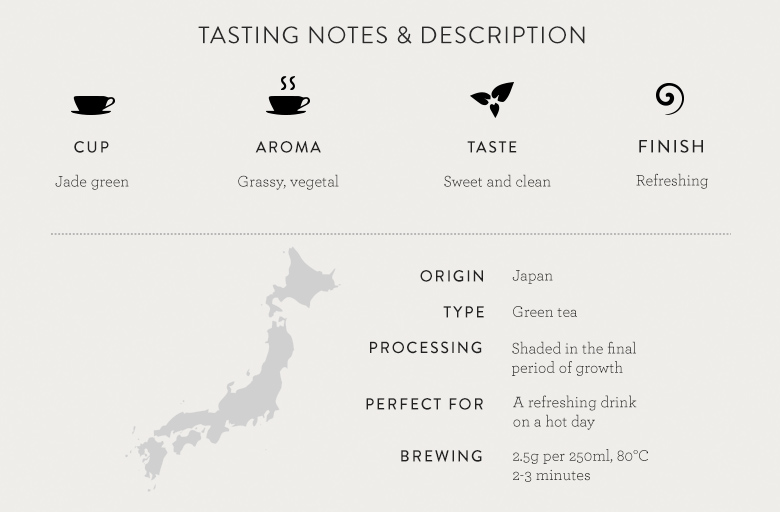This month we are looking at the queen of Japanese teas, Gyokuro. The name Gyokuro means “Jade Dew”, a reference to the beautiful glossy green infusion this tea gives. The secret behind this tea’s incredible depth and umami is the process of shading the tea plants in the weeks leading up to harvest.
Japan is one of the most prestigious tea producing regions in the world. Over a thousand years ago, Japanese monks travelling around China learned of the tea plant and brought it back to Japan to help in their meditations. The Japanese used their own unique methods for the production of tea, honed over hundreds of years.
When making Japanese teas, the ‘fixing’ step, where heat is applied to the leaves to kill the enzymes and prevent oxidation, is usually done with steam rather than the dry heat used in China. This heightens the umami and grassy flavours of the tea. Most of the green tea made in Japan is therefore known as Sencha, meaning ‘steamed tea’.
Gyokuro came to exist partly by accident. In 1835 a renowned tea merchant called Yamamoto Kahei travelled from Edo (now called Tokyo) to Kyoto to buy tea and learn about the tea making process. In the cold northern tea fields of this region it was common practice to cover the tea bushes with straw to protect them from frost. It was a particularly long and harsh winter at this time, so the bushes stayed under the straw for an extended period. When it came to processing the leaves, the merchant noticed that the leaves were unusually sticky and that the resulting tea was incredibly sweet and flavoursome. Years of trial and error were spent before discovering that the unique flavour was a result of the shade that the straw provided during growth.
Gyokuro is the ultimate form of Sencha, and is incredibly sought after. Only a fraction of the tea produced in Japan is Gyokuro. In order to make this high-end tea, the farmer uses shading to boost the umami and sweetness of the brew. Covering the tea plants in special shade covers during the final three or four weeks before harvesting means that only around 10% of the sunlight reaches the plants. This stresses the bushes and causes them to produce more nutrients in attempt to adapt to the low light levels.
The result is a harvest that is high in amino acids such as theanine and contains higher levels of grassy chlorophyll. This in turn leads to a sweeter brew that has less bitterness. The interruption to photosynthesis is what causes the plants to undergo intense changes – the plants produces more chlorophyll to catch any light that makes it through the cover, and the balance of amino acids and sugars shift towards a sweeter tea. It is this physiological and chemical change that makes Gyokuro unique.
The flavour of this tea is uniquely grassy, sweet and clean. The aroma is reminiscent of a fresh summer’s day. Japanese teas are perfect for the summer months, so why not try the queen of Japanese teas while the weather is hot. For an interesting twist, try cold brewing Gyokuro by placing 5 grams of tea per 300ml in cold water in the fridge overnight. Next day simply strain and enjoy a cool, refreshing drink.






LEAVE A COMMENT